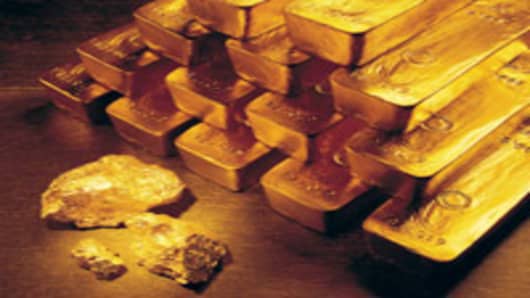After a weak summer, gold has rallied strongly over the past three months on the belief that that the dollar will continue to fall until the US economic recovery is on more solid footing.
For Rob Lutts, CIO of Cabot Management in Salem, Mass., bull markets such as gold's run in three stages—denial, acceptance and love affair.
The market as he sees it is in the second stage now, so until the love affair commences and the trade gets too frothy, he believes investors can't loose with gold.
"I think we've moved a little more into the acceptance phase," Lutts says. "Eventually asset allocation models like those that come out of big brokerage houses will be increasing their allocation to gold and making it more of a permanent sort of recommendation."
While the weak dollar has been fueling retail investor interest in the metal, it's been only in recent weeks that global central banks—for two decades net sellers of gold—have gotten in on the act as well.
"The big spenders are coming to the table," says Sean Brodrick, natural resources analyst for Weiss Research's Uncommon Wisdom Daily newsletter. "Central banks are buying and they are buying big time. If central banks are buying, that's the biggest money around and I want to be on their side of the bet."
Most recently, the Reserve Bank of India said it will buy 200 metric tons from the International Monetary Fund, half what the IMF is selling.
That's been the trend around the world as Mexico, Russia, the Philippines and Mexico all have increased their gold holdings this year.
The trend is expected to hold up and make global central banks net buyers of gold for the first time since 1988, Evy Hambro, who runs two commodities funds for BlackRock, recently told a media briefing in Australia.
"Gold's role is gathering a lot more attention in terms of risk diversification," Hambro said.
As that trade becomes more global in nature, it presents varying opportunities for investors.
While Brodrick believes gold is on its way to $1,300 an ounce, he said investors could do just as well with gold miner stocks as with the metal itself. He sees consolidation coming in the industry as mining becomes more and more the domain of large companies that can afford to look for a metal that is becoming increasingly scarce in terms of new discoveries.
"Despite the fact that gold has been marching higher for years, global gold mine production is actually going down. The reason is they aren't finding these big elephant-sized deposits," Brodrick says. "There's a real squeeze coming on. If we're not at peak gold, we might be approaching it."
One way investors can tap the mining consolidation trend is through the Market Vectors Gold Miners exchange-traded fund. The fund seeks to mimic the performance of the AMEX Gold Miners index.



